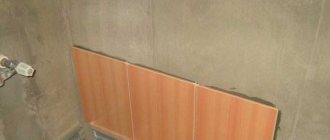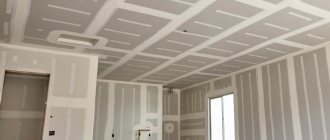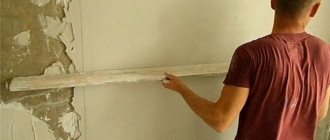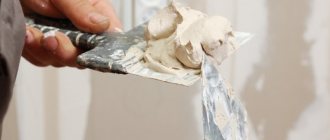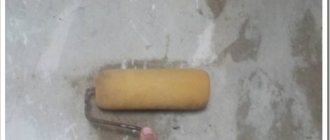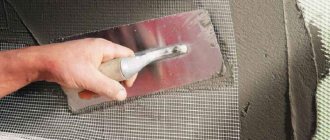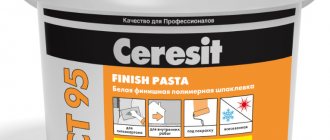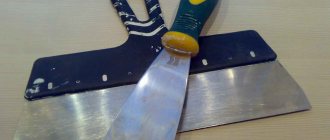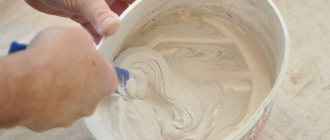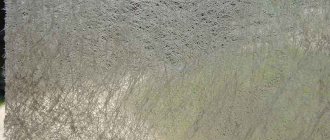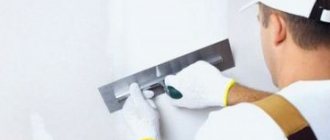About puttying without sanding. From my experience.
I was sitting, reading posts in Zen and came across a post (I won’t post the link, since this post will be an advertisement) Which is called putting putty without sanding.
After reading this post, it only made me smile.
In it, the author tells how people without experience can putty on walls so that they don’t have to sand them later. And so everything is written out that I have a question. Author, do you know how to putty yourself? A person without experience will not be able to putty easily. His hands hurt because he is not used to it. Plus he will cover the whole apartment with putty and he will be all white.
A person who has never putty will not be able to repeat it. Guys, don't even bother. It’s hard, tedious, and what’s more, it won’t be useful to you, I’ll tell you why?
The author in the article recommends putting putty under the wallpaper so as not to sand it later. Sanding is needed, not because the putty was putty poorly. If the masters read it and decided to try it, then I’ll say GUYS IN VAIN!!
This happened a long time ago and with the advent of experience, desires to reduce work begin to increase. To make it faster and create less dust.
We made an apartment and divided the apartment in half with women plasterers, since the apartment was large. They plastered one half, we plastered the other. So, when they were plastering, they rubbed the plaster straight, almost until it shined. With a phrase, and then it’s easier to putty.
Well, my partner and I thought about it and decided to do the same thing, because it’s faster, there’ll be less putty, which means it’ll be puttied faster later. And since we had one bedroom already plastered without licking the plaster. It was customary that I would lick the plaster of another room, and my partner would putty the finished room so as not to have to sand it.
Well, that means I painted the plaster with an almost mirror-like shine in the next room, and my partner also applied the putty in the other room.
It was time to putty the licked plaster and imagine my surprise when I started puttingty. The putty didn’t want to stick to the hole in any way, it was removed directly after the spatula. If I putty a simple plaster 2 times, then here I had to putty 4 times. Plus a layer to give..
We thought not to putty, but a contractor came and showed us a sketch of the wallpaper. They are light and transparent, which means they need to be puttied anyway so that there are no gaps in the wallpaper. How I remembered the Russian language when I was puttingty and swore not to do it again.
But one thought reassured me that now with putty I’ll cure it like plaster without sanding, and this will gain time. Done. Moreover, when women did their half, they disappeared somewhere. I approached the contractor and said, I won’t putty these walls. Well, well, these women never came out and we had to do everything. OH HOW WE FUCKED UP while we were putting putty on.
Fine! Done without sanding. All the walls are ready, we prime them, let them dry and glue the wallpaper. And, delivery of the object))
So we hung the wallpaper, it stuck on like a charm, good savings on glue. They glued it in one fell swoop. And while they were finishing up the little things, something not right began to happen at the facility. The seams on the wallpaper came apart in places, so I had to constantly wet and tighten them. The wallpaper began to peel off, peel off here, peel off there. And we crawl around, clean up the jambs every day, and we can’t understand why this happens. Everything was done perfectly, but no, the wallpaper is peeling off.
Our contractor noticed this, but at first did not pay attention, but the day before the commissioning of the project he began to find out from us how we prepared the walls?
Our contractor started doing repairs himself and had decent experience. Therefore, he knew what was being done and how.
We told him how we did everything according to garlic.
How we got away from him. I'll remember this for the rest of my life. How he cursed us for a long time for this, and then explained. That he kicked these women out. Because I saw that they lick the plaster and when licking it loses its roughness and then when puttying there is nothing for the putty to cling to. That's why it puts up so badly. He said that putty cannot be done without sanding. Since no matter how you try to lick it, there is a human factor and small irregularities are formed that sometimes cannot be noticed with the naked eye, but only by touch. Plus, when puttying, you still lick the putty, there are few rough edges and the wallpaper has less adhesion to the surface. Because of this, they have a much greater chance of falling off. It is sanded in order to remove most of the small irregularities and give adhesion to the walls and wallpaper. And you even berated us.
We rented out the apartment, but once a month we went and hung wallpaper until we quit.
By the way, already with a lot of experience. I decided to try to repeat the process. The result was the same.
So guys putty, don’t bother.
Rules and stages of preparation for putty
Good preparation of walls for putty should ensure the quality of the putty layer, so several requirements are imposed on the surface. The base must be:
- durable, without even a hint of any peeling;
- clean, free of paint, plaster and other finishing materials, dirt and dust.
Before starting preparatory work, wet walls must be thoroughly dried and then also cleaned of any old deposits, dirt, and dust.
If we divide the whole process into stages, then the preparation of walls for putty is carried out as follows:
- First, remove the old coating - paint, tiles, wallpaper, etc.
- Using a wide brush, moisten the base with water. The goal of the work is high-quality removal of even the slightest remnants of finishing material.
- Eliminate all defects of the wall material - recesses, seams, cracks, irregularities.
First, the gaps are widened (expanded) with a hammer and chisel, and the remnants of poorly adhering material are removed. The prepared cracks are removed (with a vacuum cleaner) from dust, dirt, and concrete residues, then moistened. Then the prepared, dried space is filled with repair mortar.
The last mandatory step is applying the primer. This operation is also advisable before sealing defects, since otherwise the adhesion of the material (plaster or starting putty) to the dusty wall will leave much to be desired.
Tools
Not a single stage of repair work is complete without tools. To carry out preparatory activities, you also need your own set. It depends on the type of coating that will have to be removed. This may include:
- Aluminum rule used to check the degree of unevenness. There are tools of different lengths, but for walls only two will be enough - 1 m and 2 m.
- Smoothers for plastering (puttying) the base. You will also need two of them - one-handed (length - 280 mm) and two-handed (500 mm).
- Spatulas for removing old finishing materials - wide working (400-450 mm) and auxiliary narrow (100 mm).
- Scraper for removing worn out finishes. It differs from a spatula in that it has a very sharp working surface.
- Drill with special grinding attachments.
- Paintbrush for applying primer.
- Needle roller for removing wallpaper.
- Sponge, roller or spray bottle.
- A small brush.
What can you use to sand walls?
It is important to use a mask while sanding walls to protect your respiratory system.
First of all, you will need to acquire the necessary equipment.
For sanding you will need:
- different types of abrasive mesh or sandpaper of different grain sizes;
- grinding bar;
- sanding sponge;
- ladder;
- additional lighting;
- spatula with a small working blade;
- individual protection means.
Experienced finishers recommend cleaning walls:
- after applying putty;
- before applying paint;
- before wallpapering.
But there are other cases when it is impossible to do without sanding.
Sanding surfaces is not a very complicated, but very lengthy process, which results in a lot of dust.
For sanding, sandpaper or a special abrasive mesh is used. What you choose depends on your preferences and wishes.
The advantage of the abrasive mesh is its perforated structure, due to which all dust will easily pass through the holes and the cloth will not quickly become clogged. Replacement of the mesh is carried out after its wear, which immediately becomes noticeable by external signs. As a result of wear and tear, the mesh may tear and not perform its intended purpose properly.
Grinding methods: pros and cons of materials
Before you do anything, determine what you will be working on. For manual work, choose mesh or sandpaper, which is suitable depends on various factors. But the manual method allows you to do the work even in hard-to-reach areas.
Pros and cons of abrasive mesh:
- The advantage of the material is perforation on the surface. This helps construction dust seep through the holes so the mesh doesn't clog like sandpaper.
- The piece in the bar is replaced as it wears out. Its degree can be determined by its external characteristics - the mesh will begin to tear - or by its operating efficiency.
- The mesh on sale is already the right size for the bar, so you don’t have to do anything additional with it. The main thing is to choose the right size piece.
- The disadvantage of an abrasive mesh is its high cost.
Abrasive mesh
Pros and cons of sandpaper:
- The main disadvantage of the material is the constant clogging with construction debris during the grinding process. Therefore, you will need much more paper than mesh.
- Plus - a wide variety of goods: pieces, rolls, small rollers.
- When purchasing ready-made cut pieces, the price of sandpaper increases.
Sandpaper
Machine sanding is required for large areas, but in the end you still cannot do without manual sanding. Among the advantages of the machine method are speed of work and practicality. Although you cannot ultimately achieve the quality of the manual method. In addition to the advantages and disadvantages of different materials and tools, other factors also influence the choice.
Grinding machine
What technology is used for sanding?
Self-sanding of walls after puttying
Before you start sanding the walls, you need to check the finish for readiness (make sure it has dried properly). To make the work comfortable and the result positive, get sufficient lighting. The rays should not be distorted and cast a shadow; the area of the wall being treated should be illuminated from all sides.
Don’t forget about personal protection that will protect your eyes and respiratory organs from dust; believe me, there will be a lot of it.
If there are large protrusions on the walls, remove them with a small putty knife, but make sure it is clean. Then place some coarse paper on the block and start sanding the walls from the top, working towards the right side. Such actions will help you not to get lost and treat the surface in small areas, without missing a single centimeter of the wall.
If you have never sanded walls and are afraid of making a mistake with the grain size of the sandpaper, test the selected abrasive on a small section of the wall in a secluded place. If scratches appear on the wall during testing, your choice is wrong, so immediately replace the sandpaper with a finer grain.
Once again I would like to mention that coarse sandpaper is suitable for preparing walls before wallpapering, but subsequent painting of the walls does not allow the presence of even the smallest flaws, which will become more pronounced after applying the paint.
When sanding, try not to apply too much force when pressing on the block and do not sand the surface in one place for too long. After performing a few circular actions, check the result and move on to the next fragment of the wall.
If during sanding after initial polishing you find significant holes on the surface, skip these areas and later treat them with putty.
When the main surface of the walls has been sanded, you can move on to the more inaccessible parts - the corners. To sand corners, do not use a sanding block, as this will only damage the putty layer. For such painstaking and delicate work, sanding sponges with a beveled angle are best suited. If you don’t have such a device, use the same fine-grained sandpaper, folding it in half.
How to sand properly without dust?
Step-by-step instruction
The grinding process must take place in several stages:
- After puttying, inspect the surface for minor defects. There should be no unevenness, voids, wet areas, or deformations on the wall that could interfere with work.
- Before sanding, wear all protective equipment: gloves, glasses, durable clothing.
- Turn on the lights if it's cloudy outside. If the day is clear, then the curtains are removed from the windows to make the lighting in the workroom brighter.
- Take a spatula of suitable size and use it to mow down all the large bumps and chips on the surface. Carry out the work as carefully as possible, so as not to waste additional effort on it later.
- First, primary grinding is performed to understand the boundaries of the processing area and the depth of sealing of small seams. They work with sandpaper from above, only after that they gradually, with smooth movements, move down and complete the processing stage.
Important: Sanding is performed on small areas one at a time. The surface area processed at a time is within 1–1.5 sq.
m.
The sanding process is much simpler than, for example, puttying or plastering. All you need to do is take a block, secure a piece of sandpaper or sanding mesh to it with clamps and start working.
You must follow the rule: first the movements are made from top to bottom, and then from left to right. You cannot sand for a long time in the same place. The tool must be moved constantly, not staying in one place to avoid gaps. If depressions have formed, do not try to smooth them out, but putty such places again, and only then sand them after they have dried.
- After sanding the main wall, emphasis is placed on corners and hard-to-reach areas.
- Then they begin wet cleaning, during which all debris is removed and dust is shaken off.
- Final sanding is carried out with small abrasive tools. At this stage, good surface lighting is necessary. After finishing sanding, the quality of the finish is determined.
Rules for laying the mixture
The mixture is laid according to certain rules so that later there are no problems with sanding. To do this, the wall is inspected, irregularities and flaws are found, due to which the quality of putty or decorative finishing will suffer.
The first layer should be applied as thick as possible. It is basic, basic, and does not require much alignment. They need to repair all visible imperfections and give rigidity to the wall itself. After drying, it will be possible to apply a thinner, neat layer (often the final, i.e. decorative) layer on it.
The first ball is applied with a spatula with a wide working base, the second can be applied with the same tool. But if you need to put a third one, you need a thinner one with rounded edges. This finishing layer, after drying, is subject to sanding.
Sand the putty on the walls carefully, without making much effort. It's better to use sandpaper. Do not press too hard on the canvas to prevent holes from appearing. There is also no need to align the recesses with the general level.
How to reduce defects to a minimum?
To ensure that as few defects as possible arise when sanding the putty, they work carefully and step by step. When the solution has completely dried, only then can you begin to level it, especially if the flaws on the surface are not very noticeable at first glance.
Attention: After the layers of putty have dried, all irregularities and defects become visible even in daylight. You need to wait a sufficient amount of time to correct all the defects in time. Sanding must be done with new tools, selected according to the type of surface being treated.
If a coarse putty based on cement or lime was used, significant defects will be visible, which can be eliminated with coarse sandpaper. This stage of defect elimination is carried out only during primary processing. At the end you should always sand the walls with the gentlest sandpaper.
Sanding must be done with new tools, selected according to the type of surface being treated. If a coarse putty based on cement or lime was used, significant defects will be visible, which can be eliminated with coarse sandpaper. This stage of defect elimination is carried out only during primary processing. At the end, you should always sand the walls with the gentlest sandpaper.
Sanding after puttying the walls is a mandatory step, as it creates a good basis for further cladding. If the leveling is initially done poorly, then further finishing does not always hide flaws and defects.
How to sand a ceiling?
We sand the ceiling with our own hands
When renovating a room, the ceiling requires no less attention than the surfaces of the walls, because all the defects on it will attract the attention of not only the owner, but also the guests of the house.
Sanding the ceiling is no different from sanding the walls. The only caveat is that working on the ceiling is much more difficult. That is why, before you start sanding this area, get a sanding machine.
If such a miracle machine is used, a mesh numbering from No. 60 to No. 80 is put on it for rough cleaning, or a mesh numbering 100 is put on it for finishing work.
To easily reach the required area of the surface, use a ladder or scaffolding, but if you have a machine with a special bar, you can sand the ceiling directly from the floor.
The surface is sanded in a circular motion until the surface has a perfectly smooth texture. Initially, sanding rids the surface of major damage, after which the remaining debris and dust are removed and the surface is examined for the presence of minor defects.
When the work has come to an end, you can cover the walls with finishing putty. After the mass has completely dried, finishing sanding is carried out with fine-grained sandpaper. The technique for performing the work is identical to that described above, the only caveat is that the movements should not be so sweeping, but neat.
When all surfaces have been sanded, it is necessary to remove any remaining dust and then prime the walls. It is the application of primer that will increase the level of adhesion of the base with subsequent finishing materials.
When deciding what materials to sand the surface and what technology to use, it is necessary not only to take into account the advice of more experienced finishers, but also to try your hand at a small section of the wall. Although today you can watch many video tutorials on the Internet, they cannot replace experience working with a grinder or other abrasive materials that you need to feel with your own hands.
Marking of sanding materials
All materials used for grouting surfaces after applying the finishing putty are distinguished by their own characteristics laid down by the manufacturers. The main ones are the size of the crumbs sawn onto the surface of the paper and cells. Therefore, they have their own numerical and letter markings.
Marking paper for cleaning surfaces
There are two types of abrasive coated paper - domestic and imported. Based on this, it differs in marking and looks like this:
- Encryption of domestic manufacturers is GOST 3647-80. The marking begins with the number 4 and ends with the value 80. They are usually followed by the letter “N” with a hyphen. The higher the digital value, the larger the abrasive grain. To bring the walls or ceiling to perfect condition, it is necessary to use emery abrasive grade: 20 - N; 16 – N; 12 - N. At the last stage - mark 10 - N.
- Material for cleaning surfaces after applying the finishing type of putty from foreign manufacturers is marked according to the FEPA or ISO 6344 standard. Material manufactured in Japan, Canada, China and the USA does not fall under them.
It is important to know! The imported font begins with the letter “P”, followed by a numerical designation from 24 to 100. The larger the number, the smaller the abrasive grain size. The mesh material used to clean up imperfections in the finishing putty is marked in the same way as foreign-made sandpaper
There is a red mark on its surface
The mesh material used to clean up imperfections in the finishing putty is marked in the same way as foreign-made sandpaper. There is a red mark on its surface.
Marking of meshes for cleaning surfaces
The code may contain other data indicating the characteristics of the mesh - moisture resistance, purpose and wear resistance. All this data helps you make the right choice. That is, one material is worth taking to remove finishing flaws, but the other is not.
The main thing is to know all these markings.
Sanding walls after puttying - advice from professionals
Date of publication: 05/01/15
Features of the grinding process
The procedure for leveling walls involves a rough finish (plaster) and a fine finish (putty). When the surface is plastered, even with the most painstaking application, small irregularities and sagging always remain on it, which are formed from the sharp corners of the spatula. These are consequences of the acceleration of the putty mass or the joining of two treated sections of the wall. Therefore, craftsmen prefer to use a large spatula to minimize the number of problem areas. And before you start polishing, the wall must dry thoroughly for at least a day. Hence the conclusion: the better the quality of work, the less hassle finishing will cause.
High-quality preparation of walls for putty and its correct application
Ideally smooth surfaces are the only condition that will give you a chance not to worry about the quality and durability of the finish. No less important is the preparation of walls for putty, since the service life of almost any finishing material depends on this composition and the reliability of its adhesion. If you skip this step, then in the future you may encounter many unpleasant surprises - cracks, partial peeling, swelling and similar defects. High-quality prepared surfaces, on the contrary, guarantee a longer life of the finishing coating, which means they make it possible to do without alterations that require additional investments.
How to sand a ceiling after puttying? All ways
If the ceiling is being prepared for painting or wallpapering, then after rough leveling the surface is smoothed with putty and sanded after drying. In everyday life, sanding the putty layer is more often called sanding or sanding - from the slang name for sandpaper “sandpaper”.
Highly qualified craftsmen perform the finishing leveling with putty so smoothly that in daylight or temporary lighting, the surface of the ceiling from a height of human height appears flawless, not requiring any additional processing. But this impression is deceptive - when the angle of incidence of light changes on the ceiling, small defects become noticeable, which in the light of a chandelier or wall lamps will be visible even after painting. The purpose of sanding is to eliminate such defects.
Why sand the walls?
Grinding may not be necessary only in two cases:
- Careful preparation is not necessary in storage areas hidden from view. There is no point in spending money on additional materials; it is enough to simply cover it with facing materials;
- There is no need to sand if your walls are already smooth. Or if the lining is dense. For example, thick wallpaper, panels and other materials do not require sanding.
In other cases, it is better to grind it. The wallpaper will stick better and its edges will not peel off. Sanding for painting is a must. The paint does not hide flaws; they will be visible to the naked eye. Even if it seems to you that the walls are smooth, sanding will not be superfluous.
What you need to sand the ceiling
The range of sanding devices on the market is quite wide and allows you to choose a tool for both one-time small-scale work and professional use.
All sanding devices can be divided into two groups:
- hand tool;
- mechanized equipment.
Let's look at each solution in more detail, starting with the most popular among home craftsmen.
Hand tool
This group includes hand graters - a time-tested tool, the models of which differ slightly from each other in design and geometry.
The popularity of manual devices is due to a number of advantages of these devices:
- Wide availability of the entire price range, starting from one hundred rubles;
- Easy to use, does not require professional skills;
- Versatility in equipping with consumables - abrasive mesh or sandpaper of various grain sizes;
- High quality results.
The following versions of graters are available for sale:
Basic option
– a handle in the center and clamps with threaded wings at the edges. Proven for decades, hand-friendly design. The disadvantage is the time-consuming procedure for replacing the skin - unscrew the wings, tuck and center the new flap, align the jaws of the clamps before tightening the nuts. Plastic tools are less durable than steel ones, but they are lighter.
Grater of a classic design or in the form of a bar
, but with mechanical spring-type clamps for covering with sandpaper - more rational solutions that simplify and speed up the procedure for replacing the sandpaper. There are grooves for fingers on the long sides of the block - this method of holding the device is more convenient when sanding walls, but taking into account the ease of replacing sandpaper, the tool is practical and suitable for sanding ceilings.
Sanding floats with articulated connection for removable telescopic handle
. The fitting can be designed for a standard handle included in the kit, or for a homemade one. The device is convenient when working from a scaffold or stepladder - it allows you to process a larger area without rearranging the support. With low ceilings, you can work with such a device without a scaffold, from the floor.
Hand graters with dust removal.
The device differs from a conventional hand tool in the connection pipe on the body, to which the suction hose of a household or construction vacuum cleaner is connected. Such a grater is more convenient when sanding walls, since the hose somewhat limits the movements of the performer, but if it is necessary to perform the work with minimal contamination, some inconvenience of using it on the ceiling is completely justified. Hand graters with dust extraction are 2-3 times more expensive than conventional devices
Ridding walls of old wallpaper
This is the first stage of work. Removing any wallpaper is quite easy if you treat it with water in advance.
- Washable wallpaper has a waterproof layer, which makes the operation somewhat more difficult. To easily bypass this obstacle, go over them with a needle roller. If it is not there, then a brush with stiff metal bristles can be a replacement. Scratched walls are moistened with warm water - a sponge or a spray bottle.
- Paper wallpaper is the most inconvenient option, since when it gets wet, it turns into a substance that tends to come off in pieces. To minimize labor, the surface is also treated with a needle roller, then generously moistened with water. After some time, remove the wallpaper with a wide spatula.
- Vinyl wallpaper is a more convenient option, because this material absorbs water very well and is easily removed. The remaining pieces are simply cleaned off with a spatula.
- Liquid wallpaper also comes off quite easily: it is first moistened with a small amount of water or treated with steam.
Alternative methods for freeing walls from wallpaper are using a steam generator or a hot iron. These devices will melt the old adhesive composition well, so separating the material from the surface should ideally be a fairly easy procedure.
Hand sanding of putty ceiling
To sand the ceiling surface you will need the following tools and accessories:
- Wide spatula with a smooth, hard blade;
- Portable lamp in a socket on a wire with an extension cord;
- Pencil;
- A grater or block with a set of abrasive mesh or sandpaper;
- Personal protective equipment – sealed glasses, a respirator, overalls (preferably overalls), a cap (preferably a baseball cap – a visor will protect your face from dust falling from above).
A portable lamp is not needed to illuminate the room - periodically bringing it closer to the ceiling, small defects are identified on the surface, their removal and the result of polishing as a whole are monitored. Therefore, it is better to install the lamp on a light tripod, which is easy to put together yourself, but you can hold the lamp in your hands.
Using a wide spatula, positioned at a small angle to the surface, all small bulges are “shaved off” from the ceiling - stripes from leveling, lumps of putty. Linear defects are removed with a longitudinal movement - this way the surface is less damaged. Each “shaved” lump will leave behind a shell that needs to be outlined with a pencil - this will remind you of it when sanding. You should inspect the surface in the direction of illumination, placing the lamp slightly to the side of you.
After going over the entire surface with a spatula, equip the grater with an abrasive of the required grain size and begin sanding.
Before starting work, you should check the plane of the mesh or sandpaper and remove from its surface any grains that stand out in size, which will certainly leave scratches on the ceiling.
Work begins from one of the walls and moves along the rays of the lamp, rearranging it as necessary, but the movement should be in the backward direction - not towards the dust, but away from it. Proper operation of the grater is cyclic movements back and forth along the direction of the light from the window. With this design, even accidentally left scratches will not be noticeable, unlike transverse or circular damage.
During the sanding process, defects may appear here and there, for example, holes from opened bubbles or cracks - any current damage is marked with a pencil.
After finishing sanding the ceiling, you need to remove any remaining dust from it; it is better to do this with a dry, soft brush with long pile, being careful not to scratch the surface with the body of the tool. Then mix a small amount of the same putty that was used for leveling, but with a more liquid consistency, and use a spatula to fill in the defects marked with a pencil. Every other day, the repair points are sanded with “zero” sandpaper.
Before priming, the ceiling that has been completely sanded is swept again with a dry brush.
You will have a more complete idea of manual sanding of a putty ceiling after watching this video:
How to quickly grout without dust?
On the walls
For walls, you first need to select a tool.
For initial sanding, use sandpaper with grain No. 60, for subsequent sanding – 120 and higher. If you need to sand large areas, it is best to do this with a sanding machine. Although you will have to spend some time manually grouting the formed depressions, corners, and recesses. After puttying, it is correct to sand the walls in the following order:
First, the entire surface is examined for flaws. To do this, you need to provide bright lighting in the room: take a powerful spotlight or hand-held flashlight, install it as close as possible to the workplace
Darkened due to the refraction of light, the depressions and potholes are outlined with a pencil so that later special attention can be paid to these places. Sanding begins from any angle. But an angular start is necessary to get a uniform result
First, a strip about 1 meter wide is determined and from the corner they move from top to bottom in movements reminiscent of a spiral. When finishing work with one strip, proceed immediately to the other part. The finishing putty should be cleaned in the same way as the starting coating. Sandpaper works well here. It evenly cleans off the formed tubercles and makes the surface smooth.
Advice: All movements should be smooth and careful. There is no need to apply any strong pressure so as not to damage the fresh layer of putty.
To level the recesses, you should not use a general level, since the grouting process can be done just fine without it. The walls become smooth and beautiful.
Video on how to sand walls after puttying with your own hands:
On the ceiling
To work with the ceiling, you need to have sandpaper and an abrasive mesh. It is best to use wet sanding. The method takes a long time, since you have to wait for each individual layer to dry. But it is very convenient for independent work. Many people find it convenient to use a grinding machine, although you can simply do everything by hand.
Stripping sequence:
- First, sandpaper with a grain of 60 is taken, after the starting layer - 120, when you need to clean up the final paint. You can use any other methods, but the ones proposed will be the most convenient, and working with paper of the desired grain size will be completed quickly.
- As on the walls, the ceiling part needs to be additionally illuminated. This is the only way to identify all the flaws and correct them. In this case, grouting should also begin from one corner, gradually moving to the other corner. It is necessary to allocate a separate lane along which the work will be performed.
- After sanding, the ceiling is primed. Once the primer layer has dried, the process is repeated if necessary. Only then is it treated with an antifungal agent.
- To effectively sand the corners between the ceiling and the walls, use a sanding block. It is also used for grouting shaped objects and protrusions.
A sanding mesh or emery material is suitable as a grouting base. If you plan to paint the ceiling later, you need to treat it at the same time as puttingty. The recessed areas need to be re-worked with putty.
From the video you will learn how to rub down the ceiling after puttying before painting:
On the floor and large surface
After the putty layer has dried, go over the entire working surface with a medium-sized spatula.
With this tool, you need to remove all protruding tubercles, formed sagging, and carefully re-fill the voluminous, deep holes. Such large flaws cannot simply be rubbed away with an emery tool. Sanding begins only after the floor surface has completely dried. They provide ideal lighting in which all flaws and irregularities are visible in order to eliminate them. First use coarse sandpaper or sanding mesh. It is convenient to attach the consumable material to a grinding block.
Movements must be of the same direction and strength. You can start grouting from any corner of the room and move in spiral circles along the entire area, selecting small pieces. After polishing one spatial area, you should gradually move on to the second, while ensuring a smooth transition (there should be no restrictions or patterns).
After going through the entire surface with a coarse abrasive, continue sanding with fine sandpaper. When sanding, bring the light source as close to the floor as possible.
Tip Corner areas should be additionally treated with sanding sponges or by adding sandpaper in several layers. This method will ensure gentle and thorough sanding of hard-to-reach areas.
Mechanical devices for grinding putty ceilings
The use of special equipment greatly facilitates sanding ceilings and speeds up the work, but purchasing such a tool for a one-time home renovation is inappropriate - the simplest device in this group costs several times more than a hand grater or block. However, if it is possible to borrow a mechanical device, this should not be neglected, so we will briefly consider the most common types of such equipment in order to try on our skills with them.
According to the principle of operation, all grinders can be divided into two groups:
Pneumatic sanders
They use the energy of compressed air supplied through a hose by a compressor, so they do not have an engine. The operating principle used determines a number of advantages of pneumatic tools:
- Light weight;
- Relatively low price;
- Simplicity of the device;
- Good performance;
- High resource.
However, the operation of these devices on compressed air also has negative aspects - dependence on a compressor, which is expensive and cumbersome, and noise.
The most affordable pneumatic devices are eccentric (orbital) sanders, equipped with a rotating disk with Velcro, to which a circle of sandpaper is attached. The disk performs a complex movement in one plane - rotating around an axis passing through the center of the circle, and at the same time rotating around another one - located a short distance from the central one. The tool is compact, lightweight and easy to maintain.
Models of pneumatic devices with dust removal and a removable telescopic handle are also produced.
Electric sanders
By design they are divided into 4 types:
- Belt - a powerful tool with an abrasive belt rotating in one direction, mainly used on wood, but also suitable for rough sanding of coarse layers of putty;
- Vibratory surface grinders - driven by a motor to a rectangular sole with a removable abrasive pad vibrating at high frequency;
- Eccentric - similar to pneumatic devices with identical action, effective for rough and finishing grinding;
- Special devices with a telescopic rod (“giraffes”) are a professional tool with high quality workmanship, but cost from 20 thousand rubles. The advantage of electric grinders is their high mobility - connecting to a power source in a residential building or area is not difficult. But the presence of an engine causes significant weight and high cost of the power tool.
Removing whitewash from the ceiling
Not only the walls need high-quality treatment, so the preparation of the ceiling is also necessary.
- The surface is moistened with water using a roller or spray. Before the liquid evaporates, the ceiling is cleaned with a scraper.
- If water-based paint was used, then instead of water, prepare a solution of laundry soap and soda (1/2 piece plus 5 teaspoons per bucket of water). In this case, wait until the paint gets wet, then scrape it off with a spatula.
Another interesting way is to use a paste made from flour. This “jelly” is spread on the ceiling with a roller, then wait until it dries. The whitewash and paste are cleaned off with the same scraper.
Working with different wall materials
Preparing walls for puttying depends on the material from which they are made, so in different cases the actions differ greatly.
Concrete
In panel houses, the base is usually flat. The only thing that may require correction is the joining seams. Reinforced concrete, concrete or expanded clay concrete often requires modification, as some defects may appear: chips or seams. Changes are not uncommon during monolithic construction; they occur due to rearranged formwork. All problem areas need plastering. The exposed reinforcement in the spalled concrete is covered with a starting putty mixture. The last stage is priming the walls.
How to minimize defects
You can completely get rid of them only by sanding, but there are solutions that can significantly reduce their number. Moreover, these solutions make leveling possible in principle. Let's look at them in more detail.
Choose the right material
To get rid of defects, you should use a universal or finishing putty. The universal one can be applied in one layer on plaster or other prepared base, the finishing one can be applied only on the base layer. They differ in composition, which affects their properties.
- Polymer. They have the greatest ductility and strength. They are easy to sand and the coating does not lose its quality over time. Acrylic is used as the main material.
- Water-dispersed. They adhere well to the surface, are elastic, and are easy to sand. They are less elastic than polymer ones, so they are easier to process.
- Oil-based adhesives based on drying oil. They feature perfect adhesion. Ideal for painting.
- Cement. When dry, they shrink, which reduces their strength and adhesion. To get rid of this drawback, manufacturers introduce plasticizing additives into the solution, which makes it more expensive. In this case, price can serve as one of the guidelines when choosing.
- Plaster. They are the easiest to process, but they are the least reliable compared to other types. Suitable for dry rooms only.
The determining factor when choosing is not only the material, but also the manufacturer. It is better to use a good gypsum mixture than a poor cement one.
Correctly laying the mixture
So that the work does not have to be redone or corrected for a long time, it is better to do everything correctly from the very beginning. Sanding walls after puttying is a rather tedious task. During the grinding process, a lot of dust is generated, so it is better to focus most of your efforts on high-quality installation of the mortar.
